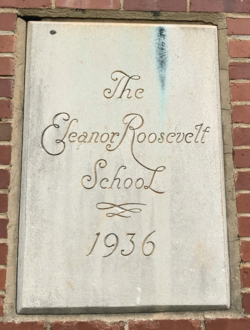| Eleanor Roosevelt School | |
| U.S. National Register of Historic Places | |
 | |
  | |
| Location | 350 Parham Street, Warm Springs, Georgia, U.S. |
|---|---|
| Coordinates | 32°53′56.32″N 84°41′6.61″W / 32.8989778°N 84.6851694°W / 32.8989778; -84.6851694 |
| Area | 6 acres (2.4 ha) |
| Built | 1936 |
| Architect | Fletcher B. Dresslar, Samuel L. Smith |
| Architectural style | Colonial Revival |
| NRHP reference No. | 10000019 |
| Added to NRHP | May 3, 2010 |
Eleanor Roosevelt School, also known as the Eleanor Roosevelt Vocational School for Colored Youth, Warm Springs Negro School, and the Eleanor Roosevelt Rosenwald School, which operated as a school from March 18, 1937 until 1972, was a historical Black community school located at 350 Parham Street at Leverette Hill Road in Warm Springs, Georgia. As of May 3, 2010, the school is listed on the National Register of Historic Places listings in Meriwether County, Georgia.
History

The school was built in 1936, with funding from the Julius Rosenwald Fund by architects Samuel L. Smith and Fletcher B. Dresslar. It was the 5358th Rosenwald School created and the last one, in dedication to President Franklin Delano Roosevelt and his vision for education.
The Julius Rosenwald Fund had closed their school building program in 1932, but President Roosevelt personally insured the creation of this school alongside Samuel L. Smith. Between 1924 and 1945, President Roosevelt visited Georgia 41 times for seeking treatment for polio, and as a result he formed close ties to the state and the local politicians. In 1927, he had co-founded the Georgia Warm Springs Foundation (now known as the Roosevelt Warm Springs Rehabilitation Center within the Warm Springs Historic District).
On March 18, 1937 the school was opened and dedicated. The school was initially created as a five-teacher community school for rural Black students during a time of racial segregation. From 1937 until the mid-1960s, the school served grades 1st through grade 8th, then from the mid-1960s until 1972 served only elementary school students. In 1972, the school closed with racial integration, eventually becoming an adult education center (from 1972 until 1975) and a day care center (from 1975 until 1977). In 1977, the building was sold to a private owner.
The school was considered historic by the National Register of Historic Places because of the significance within African-American educational history, the school's connection to President Roosevelt, and because it is an architectural example of the Rosenwald School-style with the building plans published in, Community School Plans.
In 1940, the Eleanor Roosevelt School was honored with 2 of the 33 dioramas at the American Negro Exposition in Chicago.
See also
References
- "National Register Information System". National Register of Historic Places. National Park Service. July 9, 2010.
- ^ "Eleanor Roosevelt School, National Register of Historic Places Registration Form, NPS Form 10-900". United States Department of the Interior, National Park Service. April 16, 2010.
- "Eleanor Roosevelt School, NPGallery Asset Detail". National Park Service, U.S. Department of the Interior. Retrieved 2021-03-26.
- The American School Board Journal. Vol. 117. William George Bruce, William Conrad Bruce, Susanna Cocroft, National School Boards Association. Bruce Publishing Company. 1948. p. 24.
{{cite book}}: CS1 maint: others (link) - Smith, S. L. (1950). Builders of Goodwill: The Story of the State Agents of Negro Education in the South, 1910 to 1950. Tennessee Book Company. p. 84.
- The World Almanac & Book of Facts. Facts on File, Inc. Newspaper Enterprise Association. 1938. p. 237.
{{cite book}}: CS1 maint: others (link) - "American Negro Exposition 1863-1940, July 4 to Sept. 2, 1940, Chicago, IL" (PDF). Living History of Illinois. Archived (PDF) from the original on 2017-03-03.
- Buildings and structures in Meriwether County, Georgia
- Government buildings completed in 1937
- National Register of Historic Places in Meriwether County, Georgia
- African-American history of Georgia (U.S. state)
- 1937 establishments in Georgia (U.S. state)
- Historically segregated African-American schools in Georgia (U.S. state)
- Rosenwald schools in Georgia (U.S. state)